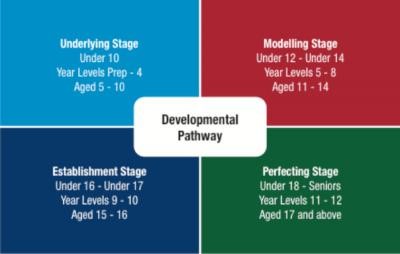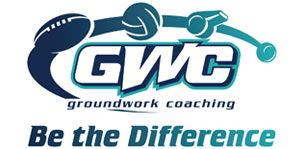An overview of the development stages for AFL
What Do I Teach at Each Age Group when coaching AFL?
Below is a summary of the content that should be taught at the relevant areas. It is one thing to teach the what, but equally important is incorporating the how. Groundwork Coaching does all of this in their comprehensive coaching manuals and below we give you a sample of what is on offer.

Underlying Stage (Chapter 4, p39)
Stage 1 (Year Levels Prep- Year 4/ Under 10)
Aged 5-10 years
Learning Intention:
- Introduce students’ involvement and educate them with regards to theunderlying skills associated with Australian Rules football.
- The emphasis at this stageis adopting a well-structured program that focus’ on participation and enjoyment.
- The emphasis is on the overalldevelopment of the players’ principal motor skills using game-related, skill-development activities such as minor games. This is a critical period for motor skill development.
- This stage can bebroken down further into Lower Primary (Prep – Year 2/5-7 years) and Upper Primary (Year 3 – Year 4/8-10 years).
Divided into 2 age groups
- Aged 5 – 7 years
Experimental: (Ball familiarisation: rolling, stopping, picking-up, dribbling, catching, kicking, bouncing , handballing, tackling, checking skills, evasion and ruck work)- all through minor games
- Aged 8 – 10 years
Mastering (kicking, handball, marking, bouncing, tackling, ruck work and evasion) – all through modified games
Modelling Stage (Chapter 6, p55)
Stage 2 (Year Levels 5 – 8/ Under 12 – 14)
Aged 12-14 years
Learning Intention:
- To be able to learn all the principal skills of the game anddevelop basic physical competencies. Consolidating the basic skills of the game.
- Introduced toboth technical and tactical skills, including positional play and basic performance-enhancing techniques, e.g. warm-up, cool-down, dietary needs (nutrition/hydration), recovery, goal-setting etc.
- Thefocus of training is on learning rather than competing, and it is imperative that there is a balance between training and playing.
- The focus is still very much about fun and participation!
Begin to unpack the skill – through games
- Kicking(stance, ball drop, transfer of weight, follow through, recovery)
- Handball(body position, platform hand, follow through, recovery)
- Marking(hand position, body position, flight and landing phase)
- Picking up the Ball(Body position, hand position, pick-up, recovery)
- Bouncing(Feet and hand position, transfer of weight, recovery)
- Tackling, shepherding and smothering(hand position, body position transfer of weight, recovery
Specialised Skills
- Bumping(body position, transfer of weight, recovery)
- Changing Direction(body position, baulking, blind turn, acceleration)
- Running(technique, receive, find space)
Tactical Skills
- Positional Play(rotation, zone specific)
- Team work(Sharing the ball, scoring zone, manning up and zoning off)
Establishment Stage (Chapter 6, p55)
Stage 3 (Year Levels 9 – 10/ Under 16 – 17)
Aged 15-16 years
Learning Intention:
- To be able todevelop higher-level skills of the game and physical competencies.
- The aim is toexpand on the development of fitness, individual, positional and team skills covered in the Modelling Stage.
- Develop higher-level competition skills throughmodified games and game sense, where players are provided with appropriate competition through decision making drills to enhance learning.
Consolidating skill – all through game sense
- Kicking(types of kicks, when to use them, kick to space, off ground and on the run, shots at goal)
- Handball(types – rocket, top spin, bounce, non-preferred, situations)
- Marking(utilising marking technique in contested situations)
- Ground Balls(picking up, stationary, moving towards, away and sideways)
- Work Rate(staying in the contest – work ethic, keeping your feet, guarding space)
- Defensive Skills(tackling, spoiling, shepherding, smothering)
- Running/Agility(receive, support, defend, create, crumbing, working the mark, bumping)
Tactical Skills
- Stoppages(set-up, positioning, objective, tap work)
- Forward Play (set ups, creating space, leading, defending)
- Defensive Play(restricting space, zoning off, transition, ball movement from defence)
- Set Plays(ATG, CB, BTI, kick ins, kick outs)
- Positional Play(experience playing all positions – feedback)
- Team Work(decision making, execution, communication,. Protecting team mates, backing up team mates)
- Game Style(run and carry, switch, countering situations e.g. loose player in defence)
Perfecting Stage (Chapter 6, p55)
Stage 4 (Year Levels 11 – 12/ Under 18 – Seniors)
Aged 17 years and above
Learning Intention:
- To consolidatehigher-level skills of the game and physical competencies.
- Maximise the development of the individual (both personally and professionally) through fitness, positional play, team and competition skills.
Specialised building on the skillset already established
- Defensive Play(General principles, transitional play, restricting space, communication)
- Forward Play(General principles, creating space, defensive pressure, communication)
- Midfield Play(work rate, reading the game, roles, stoppages, communication)
- Set Plays(CB, ATG, opposition kick ins, team kick ins, style of play, switch, running from the back half)
- Team Rules and Game Plan(need to establish these as a club – practise!!)

Recent Comments